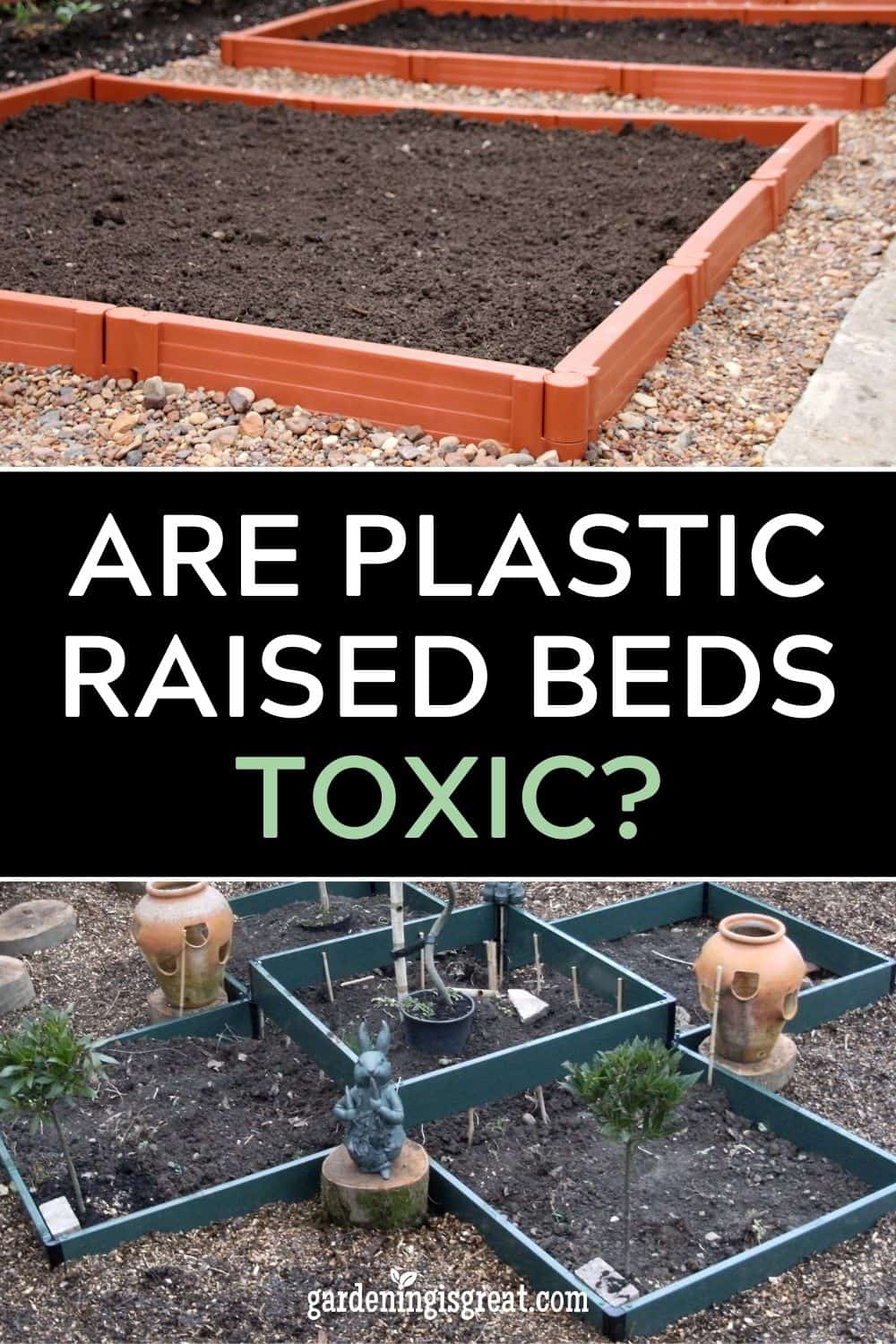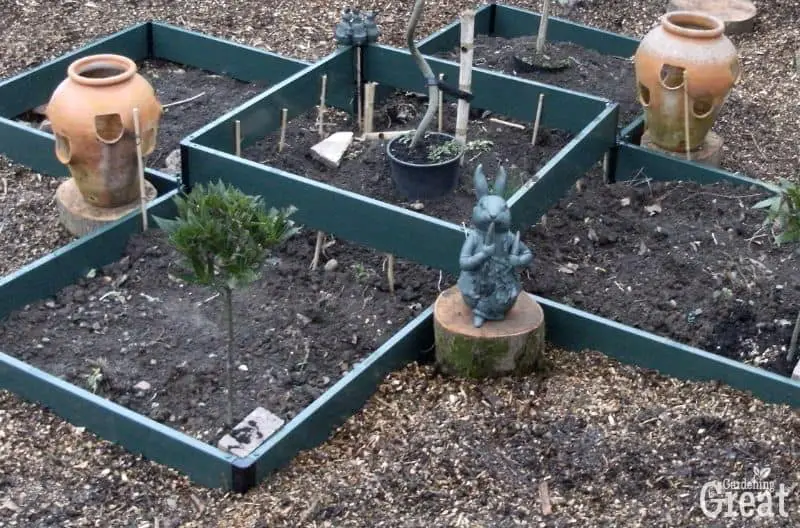Are Plastic Raised Beds Toxic? The Truth!
Plastic raised beds are becoming more popular due to their ease of maintenance, appealing appearance, and durability.
But with plastic being a popular eco topic, it is brought to our attention to consider whether the plastic used to create raised garden beds is actually safe? Or are toxins from plastic seeping into your home-grown fruits and vegetables?
The good news is most plastic raised beds are made from high-density polyethylene, which is not toxic!
Let’s take a closer look at why such a controversial material is used in our back gardens and if it truly is the best resource for building raised garden beds.

What are plastic raised beds?
A raised garden bed is an area of your garden raised off the ground often around 6-12 inches.
The soil is surrounded by a sturdy material and frequently fitted into a square or rectangle shape.
Plastic raised beds refer to the material used to build raised garden beds. Most often it is made from high-density polyethylene (HDPE), a type of plastic made from petroleum.
HDPE is durable and extremely versatile. It is often used to make milk jugs, shampoo bottles, pipes, and plastic bottles.
A lot of the HDPE used to create raised garden beds is from recycled HDPE e.g. from old milk jugs.
Why use plastic as a material for raised garden beds?
Compared with other materials that can be used for raised garden beds, plastic is one of the best options, and for good reason. Here are some of the advantages of using plastic as a material for your raised garden beds:
Durable
HDPE is incredibly durable. It lasts a lot longer than other materials such as wood and does not crack or chip. This is particularly beneficial if you live in an area with sudden temperature and weather changes. Plastic maintains its shape and can last 25+ years.
Range of Finishes
Unlike other materials e.g. stone, plastic can be easily manipulated and altered to suit your personal preference. Plastic raised beds are often dyed in a range of colors to provide you with a variety of styles.
Easy to Maintain
Plastic has a smooth finish and is easy to wash and upkeep. It is the ideal choice for someone who enjoys a pristine, clean garden that doesn’t take too long to maintain.
Recyclable
For the eco-conscious reader, if you have used plastic raised beds the great news is that they are most probably recyclable.
As many plastic garden beds are made from HDPE, it is considered incredibly valuable due to its durability and versatility, that it can be recycled again and again to create new products.
So now that we have covered a range of advantages for using plastic compared with other raised bed materials, let’s address the key question:

Are plastic raised beds toxic?
The good news is, no, plastic raised beds are not toxic.
As mentioned, most of the time the plastic used for raised beds is from HDPE. This is what’s called a ‘stable’ material. The plastic used is chemically inert, meaning any chemicals within the plastic itself cannot leach into the soil.
So if you are considering making your raised garden beds using plastic you can feel at ease. The plants you choose to grow, whether it be carrots, thyme, or broccoli, will not be affected by chemicals within the plastic.
Although plastic raised beds are safe and non-toxic, you do still need to consider the following disadvantages before finalizing your decision on which materials to use:
Pricey
Due to its quality and durability, it can be quite an expensive option in terms of materials for your raised beds. However, they should last over 25+ years, though it can feel like a big upfront cost, you save in the long run.
Flexible
Plastic is incredibly flexible in comparison to wood. If you’re not careful when handling each piece for your raised bed, the pieces can bend out of shape. Ensure to lift each piece evenly so that it maintains its shape.
Alternative materials to use for a raised garden bed
If you are still unsure as to whether plastic is the right material for your raised beds, here are some alternative materials for you to consider:
Wood
Using wood offers a natural appearance within your garden. It is usually easy to clean and sturdy. However, wood can chip and bow over time losing its shape and definition. Wood also needs to be lined so that the chemicals it has been treated with do not leach out into the soil.
Steel
Steel is strong enough to be able to maintain its shape over time and hold the soil in place. It naturally weathers changing its color over time. Similar to plastic, using steel does not leach chemicals into your soil
Composite Lumber
Composite lumber is made from a mix of wood fibers and recycled plastic materials. Both are non-toxic substances and hence no chemicals will leach into your soil. It is a great eco-friendly option that is also long-lasting due to being resistant to rotting.
Cinder Block
Cinder blocks are mostly made from concrete offering a cheaper alternative material to building your raised beds. Cinder blocks are highly durable as you don’t have to worry about them chipping or rotting and they maintain their shape. However, they are extremely heavy and will require a lot of manual labor to build your raised garden.
What is the best material for a raised bed?
As there is a range of materials out there to choose from, it can be difficult to know what is the best option for you.
So to help you choose here are three things to consider:
- Durability
How long do you want your raised garden beds to last? If they are temporary, then select the cheapest material. However, if you plan on having them for a long period of time, then it is worth the upfront extra cost for a more durable material such as plastic or composite lumber.
- Appearance
Appearance is a personal preference but can make a difference to how your garden feels to you. If you’d prefer a more natural appearance, wood would be the best choice. However, if you would like to select from a range of colors, it may be best to select plastic as this can be painted.
- Expense
Affordability is key in which material you will choose for your raised beds. Longer-lasting materials save you money in the long run but cost more upfront. If you are looking for the most affordable material then cinder blocks are the best choice. If you want something that will last a lot longer and save you money in the long run, then plastic may be a good choice.

In summary, plastic raised beds are not toxic and are a really good choice of material for you to use. Plastic is durable, customizable, and saves you money in the long run due to its lack of wear and tear.
Plastic garden beds can also be recycled once they are finished with making them an eco-friendly option also.
If you are considering building raised garden beds and which material is best, plastic is a safe, non-toxic option with several advantages over other materials.
And while we are on the subject, check out some of our other raised bed, and gardening guides:

